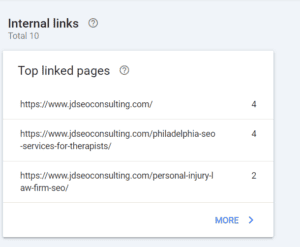Search engine optimization, or SEO, is the process of meeting a search engine’s requirements to rank higher in search results. Each search engine – Bing, Google, Yahoo! and others – has its own unique set of requirements driven by an algorithm. This algorithm measures factors like loading speed, content relevance, internal links, and more, and optimizing each factor is critical for improving a page’s rank.
What is the correct number of internal links per page for SEO? Search engines protect their proprietary algorithms, so the number is not readily available. However, according to SEO experts, one internal link per 200 words on the page is ideal. There is no limit on the number of internal links per page, and there is no penalty for having too many.
Internal vs. External Links
When creating content for a webpage, SEO experts recommend a healthy balance of internal and external links. Each one serves a unique purpose, and using them correctly pushes content higher on the search engine results page (SERP). While internal links serve the primary purpose of keeping a visitor on the website, external links can maximize the credibility of the content on the page. Check out this video by Julian Goldie SEO for more information about the difference between internal and external links.
Understanding Internal Links
Internal links are clickable hyperlinks attached to five or fewer words within a piece of content on a page. When the reader clicks one of these links, they are immediately directed to the webpage associated with that link. There are numerous benefits associated with using the correct number of internal links per page, including the following:
- Lowering a page’s bounce rate
- Keeping visitors on the site for a longer time
- Improving the overall user experience
- Spreading link equity throughout the website
- Helping Google locate and crawl other pages on the same site
- Driving traffic to the most important pages on the site
- Increasing the number of page views
- Improving keyword rankings (with SEO-optimized anchor text)

Best Practices for Internal Links
Although Google (and other search engines) do not outwardly provide specific information about their crawling and ranking algorithms, the following best practices can ensure optimal results.
- Optimize the anchor text. The anchor text you choose in your current page should include the keyword you want the linked page to rank for – not the current page’s keyword.
- Link to the most important pages on the site. Avoid links to pages with high bounce rates or low returns. Link primarily to pages that help your business earn revenue.
- Choose pages that you want to rank higher. The more internal links directed to a specific page on your site, the more important Google considers it.
- Link only from relevant pages. When building the right number of SEO links per page, be sure that you avoid linking unrelated pages. Google’s algorithm considers relevancy important, so only link pages that are closely related.
- Link as much as possible. Most SEO practitioners agree that you should use at least one internal link for every 200 words on the page. There’s no penalty for having too many internal links.
- All internal links should be “dofollow” links. Using “nofollow” will drastically and negatively impact link equity, negatively impacting SEO.
- Don’t put site-wide links in footers. Google (and other search engines) see this as spam, which can harm your SEO efforts rather than supporting them.
Understanding External Links
While there is no limit on the number of internal SEO links per page, external links come with more rules. External links can improve your site’s reputation and enhance the user experience at the same time. Most importantly, these links allow the other domain to take over some of the SEO authority, which can drastically improve the quality of your site’s pages. Benefits of external links may include the following:
- Providing readers with other sources that relate to the page subject
- Improving your site’s authority
- Increasing your page’s rank
- Giving the content on the page credibility
- Improving the visibility of your site through the ability to click through and share

Best Practices for External Links
Like internal links, Google (and other search engines) do not provide clear-cut rules for external links, but the following best practices are ideal.
- Link to relevant pages and sites. The external links on your pages help Google learn more about your content and site. They give Google clues about the keywords and topics that each page should be ranked for.
- Choose the most trusted and authoritative sites within the niche. Though it can be tempting, avoid stuffing your content with links to just any site. Choose sites (and pages) with plenty of authority to boost your own site’s reputation.
- Don’t use too many external links. Doing so can take people away from your website, and in some cases, Google may see your content as spam. Ideally, look for no more than three to five links per page for SEO purposes.
How Many Links Per Page for SEO Should You Use?
Internal and external links are both vital to the success of your site due to their impact on SEO. According to best practices, aim for one internal link every 200 words and no more than three to five external links per page. Make sure your links are relevant and associated with the correct anchor text, and always be sure that you link to high-ROI pages on your own site – or only to trusted, credible, and relevant external sites.
Want to take your SEO to the next level? Get in touch with JD SEO Consulting today! Give us a call at 856-534-3230, or jdseoconsulting@gmail.com. We specialize is a variety of industries, and employ only the best SEO strategies to boost your business’s rankings.
